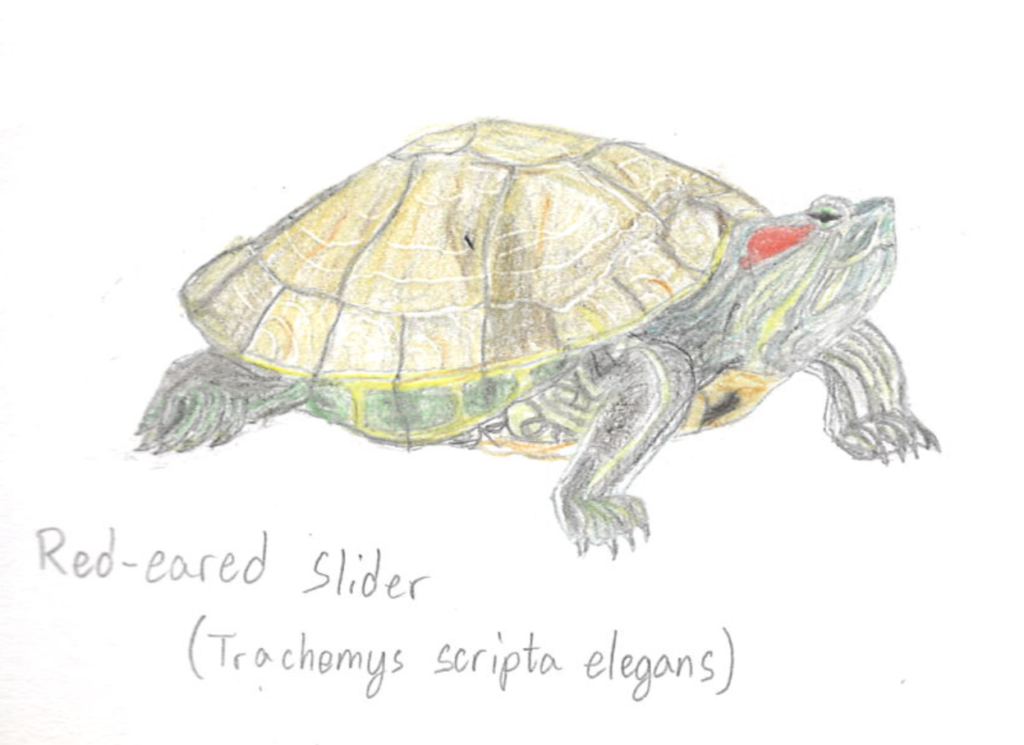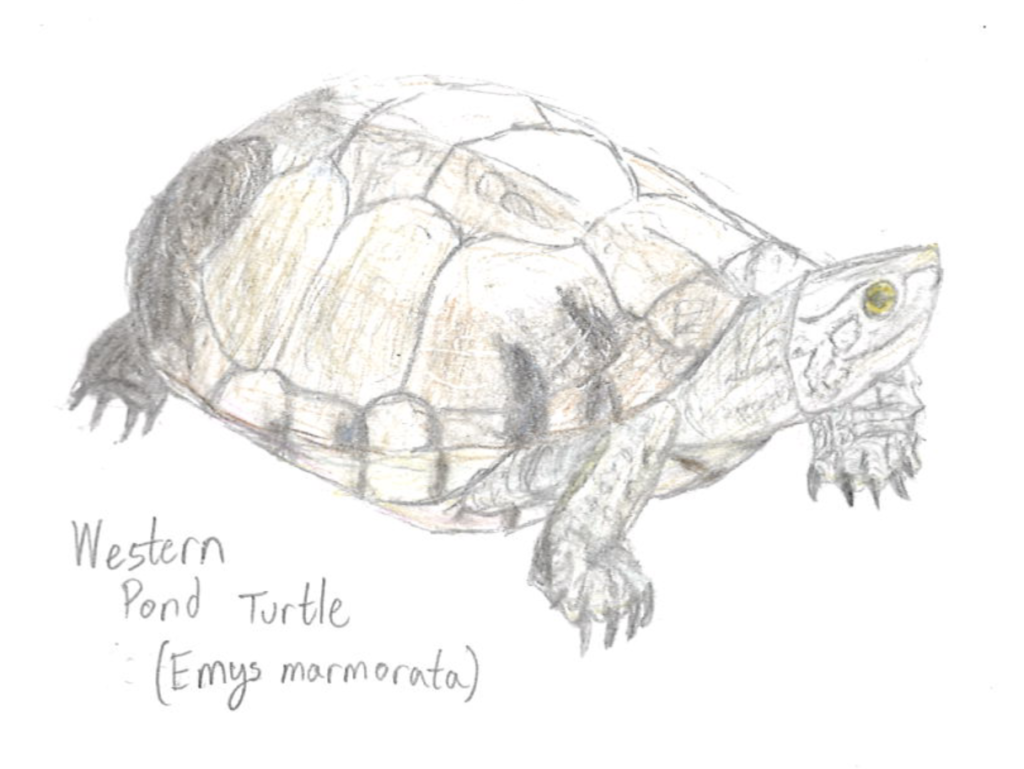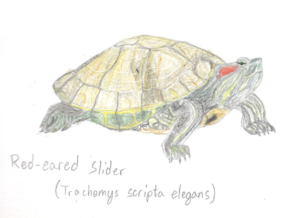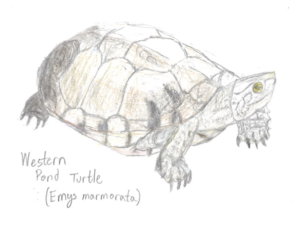
Teenage Mutant Ninja Turtles Introduces Invasive Pond Sliders
The 1990 release of the hit movie Teenage Mutant Ninja Turtles increased the desire to own exotic turtles as pets. One of the turtles in the movie, Leonardo, was based on a red-eared slider, a medium-sized freshwater turtle. These turtles have a thick red stripe behind each eye that resembles the red colored mask of the ninja turtle. The native range of these turtles includes the Mississippi Valley from Illinois to the Gulf of Mexico, extending east to West Virginia and west to eastern New Mexico. These aquatic turtles occupy many natural streams, rivers, ponds, lakes, swamps, and marshes.
Exotic red-eared sliders are inexpensively sold at pet stores around the world, including Petco. They are also sold online and even shipped to homes. Often given as prizes at carnivals, these turtles are usually impulse bought without much consideration for their care or well being. According to the California Department of Fish and Wildlife, “More than 52 million individual sliders were exported from the United States to international markets between 1989 and 1997.”
Red-eared sliders are a long-term commitment as they can live up to 40 years in captivity and reach 12 inches in length. When full grown, they require a large tank or small pond that can hold over 100 gallons of clean water. Turtles are susceptible to many illnesses and disease, so proper care is crucial for a healthy turtle. Like all reptiles and many other animals, red-eared turtles also carry salmonella, and due to causing salmonella outbreaks, selling baby turtles measuring less than 4” in diameter is illegal in the US.

Aquatic turtles have fixed tongues, and therefore they eat underwater to help them swallow the food. Female red-eared sliders lay up to 6 clutches of 30 eggs per year. With turtles, temperature determines the gender; most females hatch at 84 degrees Fahrenheit or higher, and most males hatch at cooler temperatures. Red-eared sliders also enjoy basking in the sun when and hibernate October to April at the floor of their home.
In response to their growth after being impulse bought, people usually “free” their turtles at local bodies of freshwater. They may also escape or are released for religious reasons, such as ceremonial wildlife release events originating from the traditions of Buddhism and other Asian religions. A research study on the religious release of invasive species found that increased knowledge of the negative impact of invasive species reduced the probability of release. Therefore, public education on invasive species is key to preventing the religious release of invasive species.
Once released, the red-eared slider population rapidly increases. These pond sliders are now globally invasive as they wreak havoc in habitats around the world. The species is listed in “100 of the World’s Worst Invasive Alien Species,” a list of invasive species compiled by the Global Invasive Species Database in 2014. Red-eared sliders are also found here in San Diego.
In California, red-eared sliders now compete with native western pond turtles (also called pacific pond turtle) for food, egg-laying sites, and basking sites. The native western pond turtle species was under review for listing under the Endangered Species Act in 2019, but did not pass. A study by Peerj studied the effects red-eared sliders have on western pond turtles’ body conditions and habitat use in the University of California, Davis’s Arboretum waterway. After unsuccessfully using standard turtle trapping methods to catch and remove the sliders, the researchers entered the water with dip nets. They also recorded the body mass and length measurements of western pond turtles. After the invasive species was removed, the western pond turtles were growing larger and experienced an average of 40 grams or around a 5-15% in body weight. In addition, the western pond turtles spread evenly instead of being clustered in the waterway. Although the invasive species removal proved beneficial, it was also costly.
In October of 2008, the final project report for Pacific pond turtle surveys and habitat restoration plan of San Diego was published. The plan was to remove as many invasive and exotic species possible to support the native turtle populations. Through this habitat restoration they hope to restore the habitat to its original state and provide the ideal home for the western pond turtles.
The Los Peñasquitos Preserve has a creek that was historically a seasonal hydroperiod that has become perennial as a result of the effects of urbanization. One Pacific pond turtle was captured on County property within Los Peñasquitos Preserve during the August 2007 surveys. Friends of Los Peñasquitos Preserve have many volunteer opportunities to take action for the reserve even with the Coronavirus.
The San Diego Humane Society advises turtle owners to re-home their pets to a friend and to not abandon their pets in local environments. There are too many turtles in need of pond homes, so they suggest that even though turtles are invasive, to not take them from the wild to add to the captive turtles. A valid sportfishing license is required to take the turtles, but it is only advised if they will be kept for their whole lifespan. Restoration projects or removal efforts in California require that humane methods of euthanasia are used to reduce or eradicate populations of red-eared sliders in order to protect and preserve the native ecosystems and wildlife. Pond owners that would like to help home captive turtles may email rescue@sdhumane.org to join their list of available pond homes.
Sources:
https://www.mirror.co.uk/news/uk-news/teenage-mutant-ninja-turtle-fans-4444016
https://carolinawildlife.org/the-peril-of-red-eared-sliders/
https://reptifiles.com/red-eared-slider-care/buying-a-red-eared-slider/
https://www.thesprucepets.com/red-eared-sliders-1238387
https://wildlife.ca.gov/Conservation/Invasives/Species/Redeared-Slider
https://wildlife.org/invasive-turtles-impact-western-pond-turtles/#prettyPhoto
https://sdmmp.com/upload/SDMMP_Repository/0/1v9nqstkzmw2xbjr5cdyfh7340pg68.pdf
https://esajournals.onlinelibrary.wiley.com/doi/full/10.1890/ES12-00368.1

